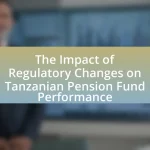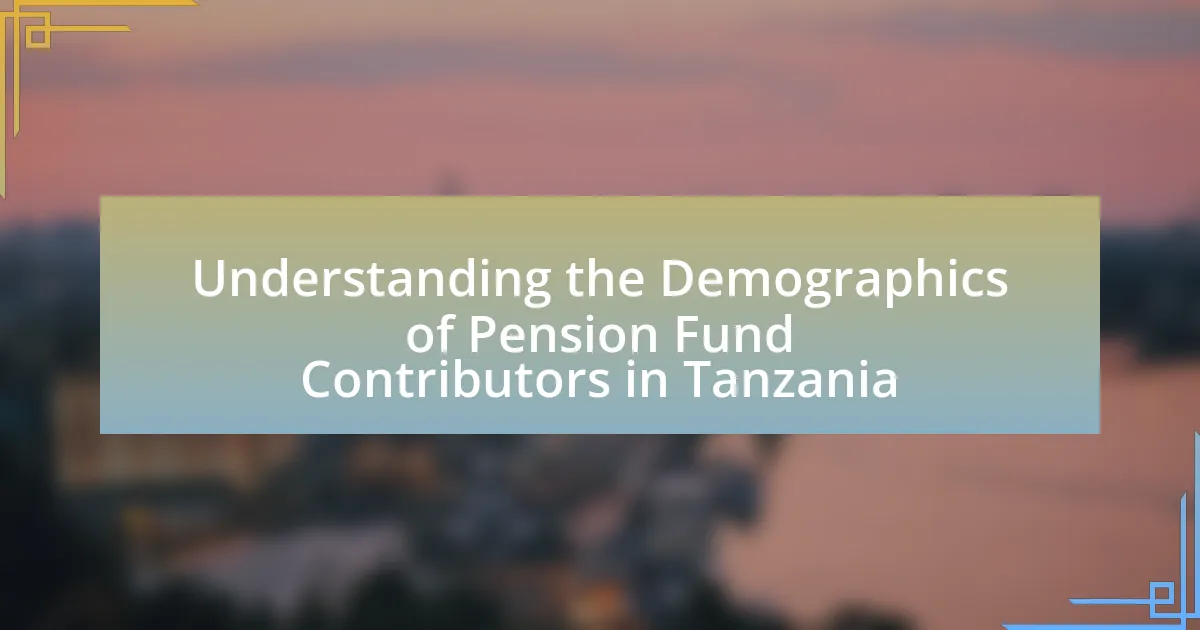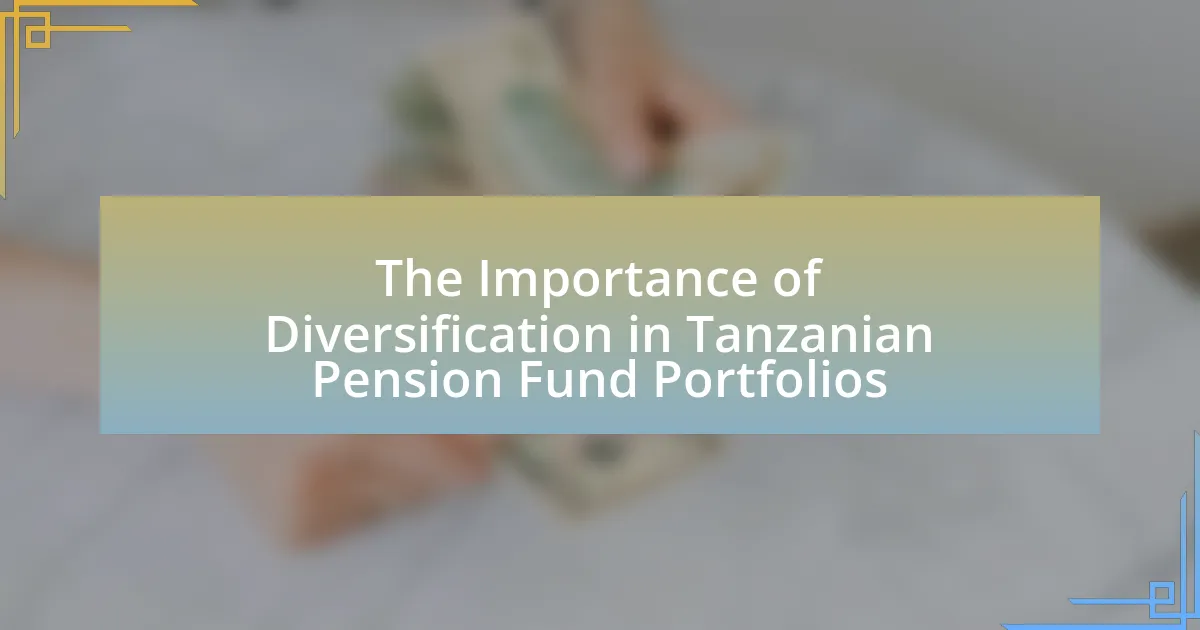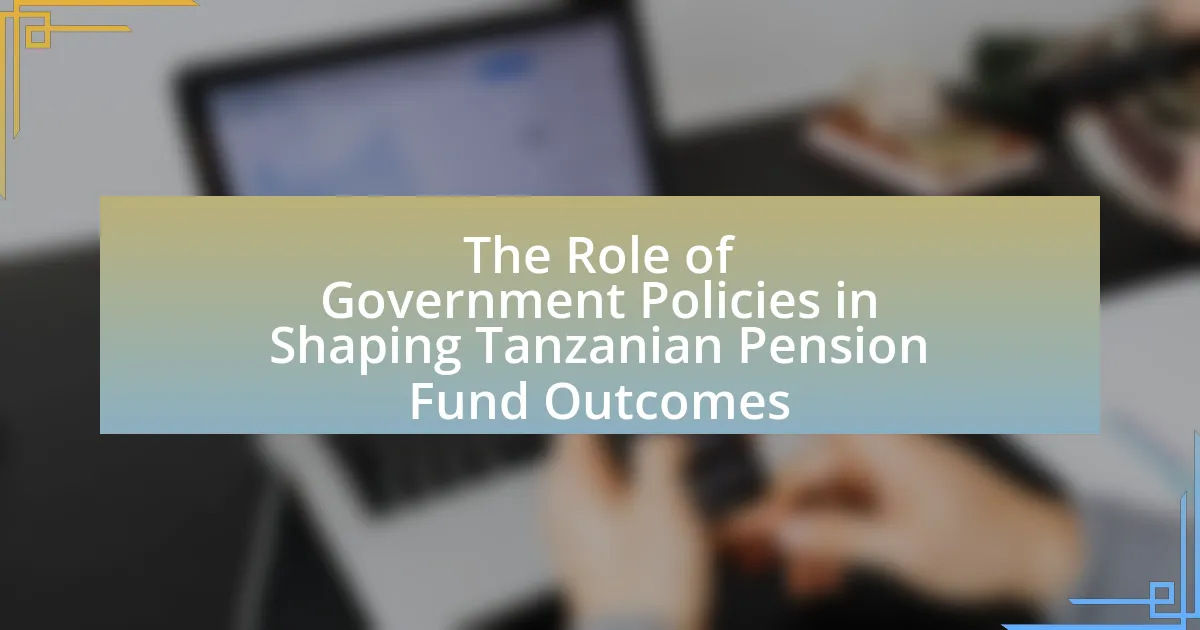The article focuses on the future of pension fund management in Tanzania, highlighting current trends and predictions. Key trends include increased diversification of investment portfolios, a shift towards sustainable and responsible investing, and the adoption of technology to enhance efficiency and transparency. Demographic changes, particularly an aging population, are influencing pension fund strategies, necessitating adjustments in investment and funding policies. The article also discusses the impact of urbanization on contributions, the role of technological advancements like AI and blockchain, and the evolving regulatory landscape. Additionally, it addresses challenges faced by pension funds and outlines best practices for stakeholders to ensure sustainable growth and effective management.

What are the current trends in pension fund management in Tanzania?
Current trends in pension fund management in Tanzania include increased diversification of investment portfolios, a focus on sustainable and responsible investing, and the adoption of technology for improved efficiency and transparency. Pension funds are increasingly allocating assets to alternative investments such as real estate and infrastructure to enhance returns, as evidenced by the National Social Security Fund’s strategic shift towards these sectors. Additionally, there is a growing emphasis on Environmental, Social, and Governance (ESG) criteria, reflecting global trends in responsible investing. The use of digital platforms for fund management and member engagement is also on the rise, driven by the need for greater accessibility and real-time information.
How are demographic changes influencing pension fund management?
Demographic changes are significantly influencing pension fund management by altering the age distribution and life expectancy of the population. As the population ages, there is an increasing number of retirees relative to the working-age population, which places greater pressure on pension funds to meet their obligations. For instance, in Tanzania, the proportion of individuals aged 60 and above is projected to rise from 5% in 2020 to 10% by 2050, according to the United Nations. This shift necessitates adjustments in investment strategies, risk management, and funding policies to ensure sustainability and adequacy of pension benefits. Consequently, pension fund managers must adapt to these demographic trends by diversifying investments and potentially increasing contributions to maintain financial stability.
What is the impact of an aging population on pension funds?
An aging population negatively impacts pension funds by increasing the ratio of beneficiaries to contributors, leading to financial strain. As life expectancy rises, more individuals draw pensions for longer periods while fewer workers contribute to the fund, resulting in a potential shortfall. For instance, in many countries, the dependency ratio—defined as the number of retirees per working-age individual—has been rising, which places additional pressure on pension systems to meet obligations. This demographic shift necessitates adjustments in pension fund management strategies to ensure sustainability and solvency.
How does urbanization affect pension fund contributions?
Urbanization increases pension fund contributions by expanding the workforce and enhancing economic activity. As more individuals migrate to urban areas for employment opportunities, the labor market grows, leading to higher income levels and, consequently, increased contributions to pension funds. For instance, in Tanzania, urban areas have seen a significant rise in formal employment, which correlates with a greater percentage of workers participating in pension schemes. According to the National Bureau of Statistics, urban employment in Tanzania rose by 10% from 2015 to 2020, indicating a direct link between urbanization and enhanced pension fund contributions.
What technological advancements are shaping pension fund management?
Technological advancements shaping pension fund management include artificial intelligence, big data analytics, blockchain technology, and automated investment platforms. These technologies enhance decision-making processes, improve risk assessment, and streamline operations. For instance, AI algorithms analyze vast datasets to identify investment opportunities and optimize portfolio management, while blockchain ensures transparency and security in transactions. According to a report by Deloitte, 80% of pension funds are expected to adopt AI and machine learning by 2025, indicating a significant shift towards data-driven strategies in the industry.
How is digitalization transforming pension fund operations?
Digitalization is transforming pension fund operations by enhancing efficiency, improving data management, and enabling better customer engagement. For instance, the adoption of automated systems allows pension funds to streamline administrative tasks, reducing processing times and operational costs. Additionally, digital platforms facilitate real-time data analysis, which aids in informed decision-making and risk management. A report by Deloitte highlights that 70% of pension funds are investing in digital technologies to improve service delivery and operational effectiveness. This shift not only optimizes internal processes but also enhances member experience through personalized services and transparent communication.
What role does data analytics play in investment strategies?
Data analytics plays a crucial role in investment strategies by enabling investors to make informed decisions based on data-driven insights. By analyzing historical performance, market trends, and economic indicators, investors can identify patterns and forecast potential outcomes, which enhances the accuracy of their investment choices. For instance, a study by McKinsey & Company found that firms leveraging advanced analytics in their investment processes can achieve up to 20% higher returns compared to those that do not utilize such tools. This demonstrates that data analytics not only improves decision-making but also significantly impacts overall investment performance.
What regulatory changes are impacting pension fund management?
Regulatory changes impacting pension fund management in Tanzania include the implementation of the Pension Reform Act of 2018, which introduced stricter governance standards and enhanced transparency requirements for pension funds. This act mandates that pension funds must adhere to new investment guidelines, ensuring that funds are managed with a focus on risk management and sustainability. Additionally, the establishment of the Social Security Regulatory Authority has increased oversight, requiring pension funds to submit regular reports and comply with new capital adequacy standards. These changes aim to protect beneficiaries and improve the overall stability of the pension system in Tanzania.
How are government policies evolving in response to pension fund needs?
Government policies are evolving to enhance the sustainability and efficiency of pension funds in Tanzania by increasing regulatory oversight and promoting diversified investment strategies. Recent reforms include the introduction of the National Pension Fund Act, which aims to improve fund management and ensure better returns for contributors. Additionally, the government is encouraging pension funds to invest in infrastructure projects, which can yield higher long-term returns while supporting national development goals. These policy changes are driven by the need to address demographic shifts and the growing financial demands of an aging population, as evidenced by projections indicating that the number of retirees will significantly increase in the coming decades.
What compliance challenges do pension funds face in Tanzania?
Pension funds in Tanzania face several compliance challenges, primarily due to regulatory complexities and a lack of clarity in the legal framework. The regulatory environment is often characterized by frequent changes in laws and guidelines, which can lead to confusion and non-compliance. Additionally, pension funds struggle with inadequate resources for compliance monitoring and reporting, making it difficult to adhere to the requirements set by the National Social Security Fund and other regulatory bodies. Furthermore, the limited capacity of regulatory authorities to enforce compliance adds to the challenges, as there may be insufficient oversight and support for pension funds to meet their obligations effectively.

What predictions can be made about the future of pension fund management in Tanzania?
Predictions about the future of pension fund management in Tanzania indicate a shift towards increased regulatory oversight and diversification of investment portfolios. The Tanzanian government has been implementing reforms aimed at enhancing the efficiency and transparency of pension funds, as evidenced by the establishment of the Social Security Regulatory Authority in 2008, which oversees compliance and governance. Additionally, the growing emphasis on sustainable investments and the integration of technology in fund management are expected to reshape the landscape, as seen in global trends where digital platforms facilitate better fund accessibility and management. Furthermore, demographic changes, including an aging population, will likely drive demand for more robust pension products, prompting funds to innovate and adapt to meet the needs of future retirees.
How will investment strategies evolve in the coming years?
Investment strategies will increasingly focus on sustainability and technology in the coming years. As global awareness of environmental, social, and governance (ESG) factors rises, pension funds in Tanzania will likely allocate more resources to sustainable investments, reflecting a broader trend observed in developed markets where ESG assets are projected to exceed $53 trillion by 2025. Additionally, the integration of advanced technologies such as artificial intelligence and big data analytics will enhance decision-making processes, allowing for more precise risk assessments and portfolio management. This evolution aligns with the increasing demand for transparency and accountability in investment practices, driven by both regulatory changes and investor preferences.
What sectors are expected to attract more pension fund investments?
The sectors expected to attract more pension fund investments include infrastructure, renewable energy, and technology. Infrastructure projects, such as roads and bridges, are increasingly prioritized due to their potential for stable returns and economic growth. Renewable energy investments are gaining traction as global demand for sustainable solutions rises, with projections indicating significant growth in this sector. Additionally, technology, particularly in fintech and digital services, is attracting attention due to its rapid expansion and innovation potential, which aligns with the long-term investment strategies of pension funds.
How might global economic trends influence local pension funds?
Global economic trends can significantly influence local pension funds by affecting investment returns, funding levels, and regulatory environments. For instance, fluctuations in global interest rates can impact the yields on bonds, which are a common investment for pension funds; when rates are low, pension funds may struggle to meet their obligations. Additionally, global market volatility can lead to unpredictable asset valuations, affecting the overall financial health of pension funds. According to the International Monetary Fund, in 2021, global economic recovery post-COVID-19 was uneven, which directly influenced local economies and, consequently, their pension systems. Furthermore, changes in international trade policies can affect local industries, impacting employment levels and, in turn, pension contributions.
What innovations are likely to emerge in pension fund management?
Innovations likely to emerge in pension fund management include the integration of artificial intelligence (AI) for predictive analytics, blockchain technology for enhanced transparency, and personalized investment strategies through robo-advisors. AI can analyze vast datasets to forecast market trends and optimize asset allocation, improving decision-making efficiency. Blockchain technology can streamline transactions and record-keeping, reducing fraud and operational costs. Additionally, robo-advisors can offer tailored investment solutions based on individual risk profiles, making pension management more accessible and user-friendly. These innovations are supported by the growing trend of digital transformation in financial services, which emphasizes efficiency, transparency, and customer-centric solutions.
How could blockchain technology impact pension fund operations?
Blockchain technology could significantly enhance pension fund operations by improving transparency, security, and efficiency in transactions. By utilizing a decentralized ledger, pension funds can ensure that all transactions are recorded in an immutable manner, reducing the risk of fraud and errors. For instance, a study by the World Economic Forum indicates that blockchain could reduce operational costs for financial services by up to 30%, which is particularly relevant for pension funds managing large volumes of transactions. Additionally, smart contracts on blockchain can automate processes such as benefit disbursements, ensuring timely payments to beneficiaries while minimizing administrative overhead. This technological integration can lead to more streamlined operations and increased trust among stakeholders in the pension fund ecosystem.
What new financial products may be introduced for pension funds?
New financial products that may be introduced for pension funds include target-date funds, sustainable investment options, and annuity products with flexible withdrawal features. Target-date funds automatically adjust asset allocation based on the retirement date, providing a hands-off investment approach. Sustainable investment options focus on environmental, social, and governance (ESG) criteria, appealing to socially conscious investors. Annuity products with flexible withdrawal features offer retirees more control over their income streams, adapting to changing financial needs. These innovations align with global trends in pension fund management, emphasizing diversification, sustainability, and adaptability to enhance retirement outcomes.
What challenges will pension funds face in the future?
Pension funds in Tanzania will face several challenges in the future, including demographic shifts, economic volatility, and regulatory changes. As the population ages, there will be an increasing number of retirees relying on pension funds, which may strain resources. Economic fluctuations can impact investment returns, making it difficult for funds to meet their obligations. Additionally, evolving regulations may require pension funds to adapt their strategies and operations, potentially increasing operational costs. These factors collectively threaten the sustainability and effectiveness of pension fund management in Tanzania.
How will market volatility affect pension fund stability?
Market volatility negatively affects pension fund stability by increasing the risk of asset value fluctuations, which can lead to funding shortfalls. When markets experience significant ups and downs, the investments held by pension funds may lose value, impacting their ability to meet future liabilities. For instance, during the 2008 financial crisis, many pension funds saw their asset values decline by over 20%, highlighting the direct correlation between market instability and pension fund health. This volatility can force pension funds to adjust their investment strategies, potentially leading to lower returns and increased contributions from employers and employees to maintain solvency.
What risks are associated with emerging investment opportunities?
Emerging investment opportunities carry several risks, including market volatility, regulatory uncertainty, and lack of historical data. Market volatility can lead to significant fluctuations in asset values, making it difficult for investors to predict returns. Regulatory uncertainty arises from evolving laws and regulations that can impact investment viability, particularly in developing markets like Tanzania. Additionally, the lack of historical data on emerging investments complicates risk assessment, as investors may not have sufficient information to make informed decisions. These factors collectively contribute to the heightened risk profile associated with emerging investment opportunities.
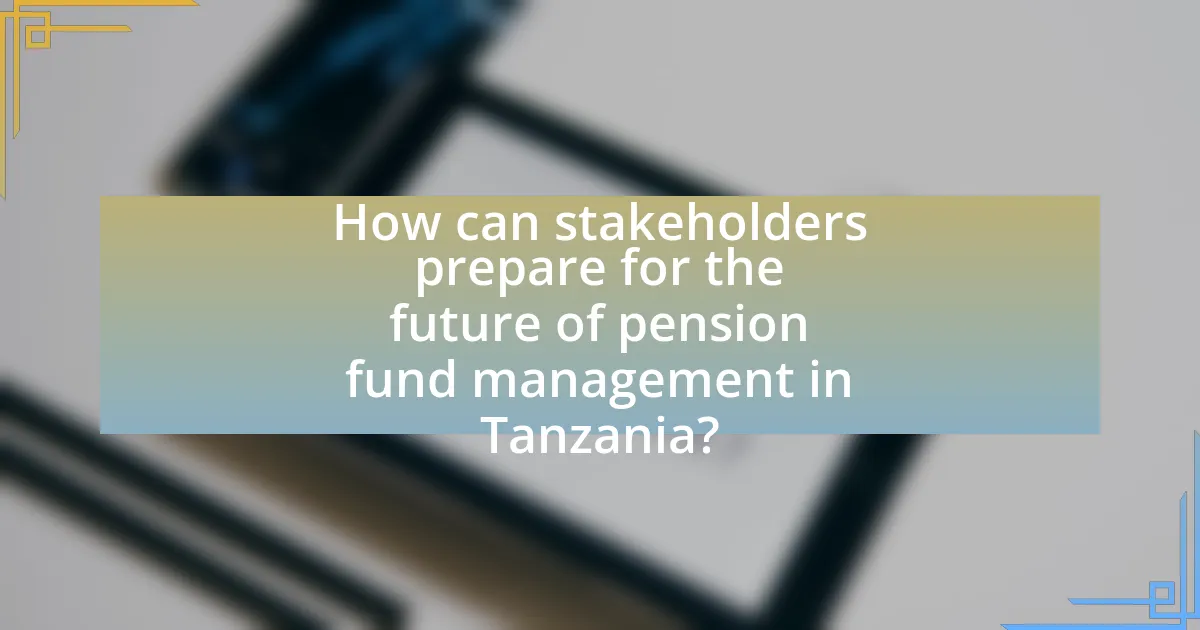
How can stakeholders prepare for the future of pension fund management in Tanzania?
Stakeholders can prepare for the future of pension fund management in Tanzania by adopting a proactive approach that includes enhancing regulatory frameworks, investing in technology, and diversifying investment portfolios. Strengthening regulatory frameworks ensures compliance with evolving laws and protects beneficiaries, as evidenced by the Tanzanian government’s ongoing reforms aimed at improving the pension sector’s governance. Investing in technology, such as digital platforms for fund management and member engagement, can increase efficiency and transparency, which is crucial given the growing demand for accountability in financial services. Additionally, diversifying investment portfolios across various asset classes can mitigate risks and enhance returns, aligning with global best practices observed in successful pension fund management strategies.
What best practices should pension fund managers adopt?
Pension fund managers should adopt a diversified investment strategy to mitigate risks and enhance returns. Diversification across asset classes, such as equities, bonds, and alternative investments, reduces exposure to market volatility and improves the overall stability of the fund. According to the CFA Institute, a well-diversified portfolio can lead to better risk-adjusted returns, which is crucial for meeting long-term obligations to beneficiaries. Additionally, pension fund managers should implement robust governance frameworks that include regular performance evaluations and transparent reporting practices, as these measures foster accountability and trust among stakeholders. Research from the World Bank indicates that strong governance practices are linked to improved fund performance and sustainability.
How can effective risk management strategies be implemented?
Effective risk management strategies can be implemented by establishing a comprehensive framework that includes risk identification, assessment, mitigation, and monitoring. This framework should involve regular analysis of market trends, regulatory changes, and demographic shifts affecting pension funds in Tanzania. For instance, the implementation of stress testing and scenario analysis can help predict potential risks and their impacts on fund performance. Additionally, integrating technology for data analytics can enhance decision-making processes, allowing for timely adjustments to investment strategies. According to the World Bank, effective risk management in pension funds can lead to improved financial stability and better outcomes for beneficiaries, highlighting the importance of these strategies in the context of Tanzania’s evolving pension landscape.
What role does stakeholder engagement play in pension fund success?
Stakeholder engagement is crucial for pension fund success as it fosters trust, transparency, and collaboration among all parties involved. Engaging stakeholders, including members, employers, and regulators, ensures that their needs and concerns are addressed, leading to better decision-making and enhanced fund performance. Research indicates that pension funds with active stakeholder engagement strategies tend to achieve higher member satisfaction and retention rates, which directly contributes to the fund’s long-term viability and growth. For instance, a study by the International Labour Organization highlights that effective communication and involvement of stakeholders can lead to improved governance and accountability in pension fund management.
How can individuals contribute to their own pension fund growth?
Individuals can contribute to their own pension fund growth by consistently making contributions, taking advantage of employer matching programs, and investing in diversified assets. Regular contributions, even small amounts, can compound over time, significantly increasing the fund’s value due to the power of compound interest. For instance, contributing just 10% of one’s salary annually can lead to substantial growth over decades. Additionally, utilizing employer matching programs can effectively double contributions, as many employers match a percentage of employee contributions, enhancing overall savings. Investing in a diversified portfolio, including stocks, bonds, and mutual funds, can also mitigate risks and maximize returns, as historically, diversified investments have outperformed single asset classes over the long term.
What savings strategies can enhance personal pension contributions?
To enhance personal pension contributions, individuals can adopt strategies such as automatic payroll deductions, increasing contribution percentages, and utilizing tax-advantaged accounts. Automatic payroll deductions streamline the saving process by directly allocating a portion of income to pension contributions, which can lead to higher savings over time. Increasing contribution percentages, even by small increments, can significantly boost the overall pension fund due to the compounding effect of interest. Utilizing tax-advantaged accounts, such as retirement savings accounts that offer tax benefits, can also maximize contributions while minimizing tax liabilities. These strategies are supported by research indicating that consistent and increased contributions lead to better retirement outcomes, as evidenced by studies showing that individuals who automate their savings tend to save more effectively.
How can individuals stay informed about pension fund developments?
Individuals can stay informed about pension fund developments by regularly accessing official pension fund websites, subscribing to financial news outlets, and participating in community forums or workshops focused on pension management. Official pension fund websites provide updates on policy changes, investment performance, and regulatory developments, ensuring that individuals receive accurate and timely information. Financial news outlets, such as Bloomberg or Reuters, often cover significant trends and changes in pension fund management, offering insights into broader economic impacts. Additionally, community forums and workshops facilitate discussions with experts and peers, enhancing understanding of local pension fund dynamics and future trends.
What resources are available for understanding pension fund management?
Resources available for understanding pension fund management include academic journals, industry reports, regulatory publications, and online courses. Academic journals such as the Journal of Pension Economics and Finance provide peer-reviewed research on pension fund strategies and performance. Industry reports from organizations like the World Bank and the International Monetary Fund offer insights into global pension trends and best practices. Regulatory publications from national pension authorities outline legal frameworks and compliance requirements. Online courses from platforms like Coursera and edX cover fundamental concepts and advanced topics in pension fund management, making them accessible for learners at various levels.
Where can stakeholders find reliable information on pension trends?
Stakeholders can find reliable information on pension trends through government publications, industry reports, and academic research. The National Social Security Fund (NSSF) in Tanzania regularly publishes reports that provide insights into pension trends and statistics. Additionally, organizations such as the International Labour Organization (ILO) and the World Bank offer comprehensive studies and data on global pension systems, including trends relevant to Tanzania. Academic journals and local universities also conduct research on pension management, contributing valuable information to stakeholders.
What organizations provide support for pension fund education?
Organizations that provide support for pension fund education include the International Pension Fund Association, the World Bank, and the International Labour Organization. These organizations offer resources, training, and guidance to enhance understanding and management of pension funds. For instance, the International Pension Fund Association conducts workshops and seminars aimed at educating stakeholders about best practices in pension fund management. The World Bank provides research and policy advice to improve pension systems globally, while the International Labour Organization focuses on promoting social security and pension education in developing countries, including Tanzania.

